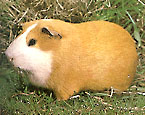|
Domesticated
Guinea Pig
(Cavia porcellus) #60-1 |
||||
|
|
Physical
characteristics and distribution
|
|
Domesticated Guinea Pigs are large for rodents, weighing between 0.5 (as juveniles) and 1.5 kg (1-3 pounds), and measuring 25-40 cm (10-15 inches) long. They live an average of four to eight years. In their wild state, Guinea Pigs are found on grassy plains and occupy an ecological niche similar to that of the cow. They move together in small groups (herds) eating grass or whatever other plants they come across. The gestation lasts from 68-72 days, which is quite long for such a small animal. As a consequence pups are already well developed (including fur, teeth, claws and full eyesight) when they are born. The young are mobile from birth, and depending on the environment, will usually venture outdoors within a week. Pups begin eating solid food after a couple of days, though continue to suckle also. The Domesticated Guinea Pig was first domesticated in about 2000 BC for food by the Inca, in the Andean region of South America, in what is now Peru and Bolivia. Dutch and English traders brought guinea pigs to Europe. How they came to be thought of as "pigs" is not clear. One thought is that some of the sounds they make reminded people of pigs. They are also built somewhat like a pig, with a large head relative to the body, a stout neck, and a rounded rump with no tail of any consequence. Domesticated Guinea Pigs come in many breeds. They are domesticated worldwide; possibly feral in N South America.
|
|
Description
of the brain
|
|
Animal
source and preparation
|
|
All
specimens collected followed the same preparation
and histological procedure.
|
Other Related Resources (websites and publications)
List of Specimens | Explore Collections | Brain Sections | Brain Evolution | Brain Development | Brain Circuitry | Brain Functions | Location and Use | Related Web Sites | Contact Us | Search MSU Database | Personnel | Home



